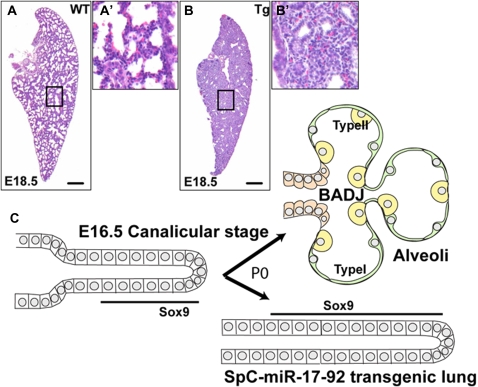Figure 2.
Transgenic overexpression of the miR-17-92 cluster in the epithelium of the embryonic mouse lung promotes expansion of the pool of progenitor cells and inhibits their differentiation. (A) Section of wild-type (nontransgenic) E18.5 lung stained with hematoxylin and eosin to show normal structure with multiple terminal sacs that will give rise to the alveoli. The black box indicates typical area, which is shown at higher magnification in A′. Scale bar = 200 μm. (B) Section of transgenic Sftpc–miR-17-92 lung at E18.5 showing the persistence of tubes lined with cuboidal epithelial cells; B′ shows area boxed in black at higher magnification. The cuboidal epithelial cells express Sox9 and NMyc (19). (C) Schematic representation of the effect of miR-17-92 overexpression. At E16.5, the terminal tubes of the lung at the canalicular stage still express Sox9 (see Figure 1D). In the wild-type lung, the terminal tubes give rise to the alveolar cells. These include type I (green) and type II (yellow) epithelial cells, whereas the more proximal cells differentiate into Clara and ciliated cells (orange). BADJ = bronchioalveolar junction; P0 = Postnatal Day 0 (birth). In Sftpc–miR-17-92 transgenic lungs, there is persistence of the progenitor cells expressing Sox9 and absence of differentiated alveolar cells.

